Tourist attractions
Gliwice is located in a rich historical and cultural region with numerous spectacular tourist attraction. I a radius up to 100 km and within 1,5 hours of travel you can reach beautiful and interesting historical places like medieval city Krakow or Auschwitz-Birkenau camp - sign of martyrdom during the Second World War. Also local attractions located in a distance about half an hour from the conference venue are interesting. Tarnowskie Góry is a town with mining traditions and unique Silver Mine inscribed to the UNESCO list and modern Katowice – capital of Silesia region is transformed recently from heavy industry town. Short description of the most interesting places you can find below.
Top attractions
Cracow (Kraków)
Former capital of Poland, the second largest and one of the oldest cities in Poland. Situated on the Vistula River. The city dates back to the 7th century. It was the official capital of Poland until 1596 and has traditionally been one of the leading centers of Polish academic, economic, cultural and artistic life. One of the most beautiful cities in Europe. The Old Town was declared a UNESCO World Heritage Site. The most important places to visit:
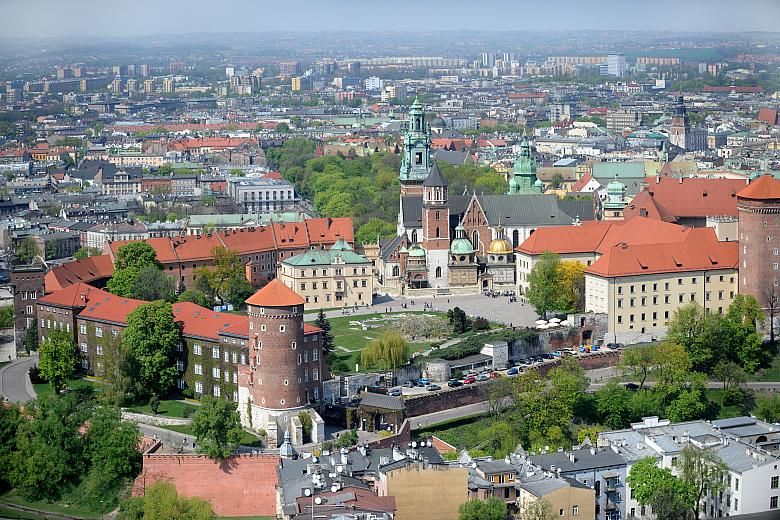 The complex consists of many buildings and fortifications; the largest and best known of these are the Royal Castle and the Wawel Cathedral (which is the Basilica of St Stanisław and St Wacław). Some of Wawel's oldest stone buildings, such as the Rotunda of the Virgin Mary can be dated to 970AD. There are also wooden parts of the complex which date to about the 9th century.
The complex consists of many buildings and fortifications; the largest and best known of these are the Royal Castle and the Wawel Cathedral (which is the Basilica of St Stanisław and St Wacław). Some of Wawel's oldest stone buildings, such as the Rotunda of the Virgin Mary can be dated to 970AD. There are also wooden parts of the complex which date to about the 9th century.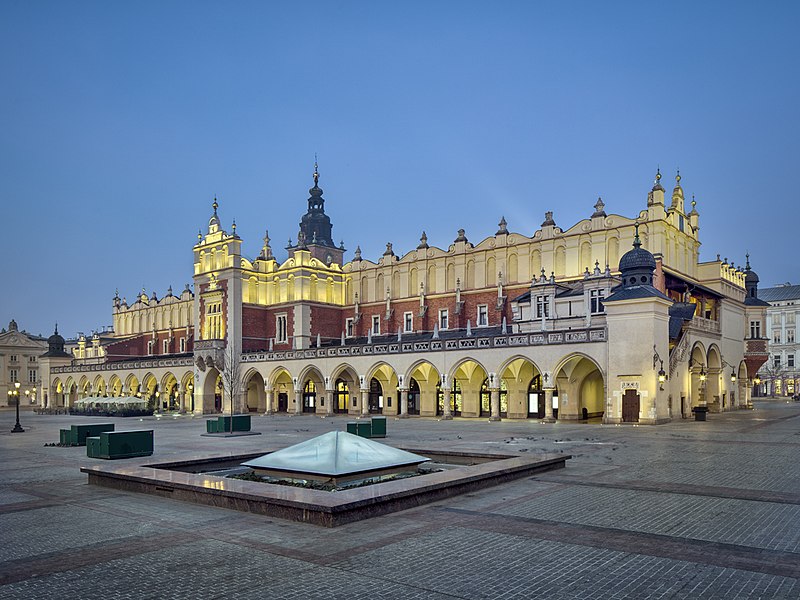 The main square is the principal urban space located at the center of the city. It dates back to the 13th century, and at 3.79 ha (9.4 acres) is one of the largest medieval town squares in Europe. The main square is a square space surrounded by historic townhouses and churches. The center of the square is dominated by the Cloth Hall (pol.: Sukiennice), rebuilt in 1555 in the Renaissance style, topped by a beautiful attic or Polish parapet decorated with carved masks. On one side of the cloth hall is the Town Hall Tower, on the other the 10th century Church of St. Adalbert and 1898 Adam Mickiewicz Monument.
The main square is the principal urban space located at the center of the city. It dates back to the 13th century, and at 3.79 ha (9.4 acres) is one of the largest medieval town squares in Europe. The main square is a square space surrounded by historic townhouses and churches. The center of the square is dominated by the Cloth Hall (pol.: Sukiennice), rebuilt in 1555 in the Renaissance style, topped by a beautiful attic or Polish parapet decorated with carved masks. On one side of the cloth hall is the Town Hall Tower, on the other the 10th century Church of St. Adalbert and 1898 Adam Mickiewicz Monument.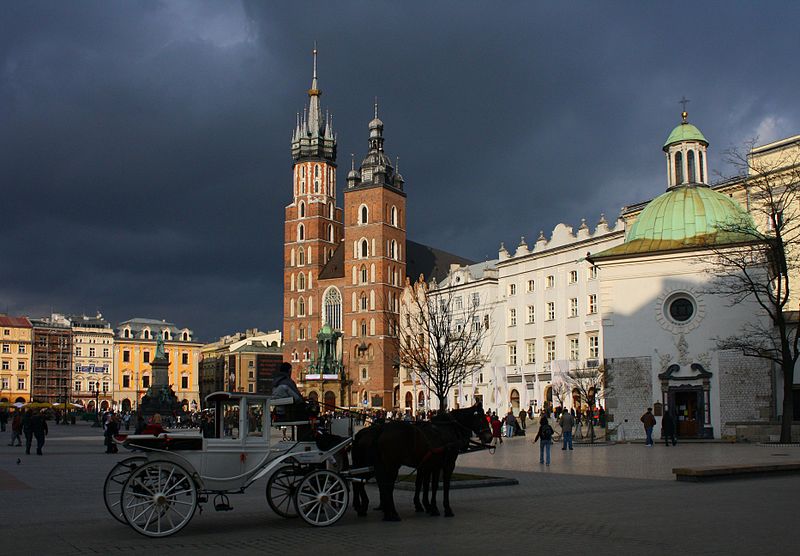 It is a Brick Gothic church adjacent to the Main Market Square. Built in the 14th century, its foundations date back to the early 13th century and serve as one of the best examples of Polish Gothic architecture. Standing 80 m (262 ft) tall, it is particularly famous for its wooden altarpiece carved by Veit Stoss (Wit Stwosz). On every hour, a trumpet signal—called the Hejnał mariacki—is played from the top of the taller of Saint Mary's two towers. The plaintive tune breaks off in mid-stream, to commemorate a famous 13th century trumpeter who was shot in the throat while sounding the alarm before a Mongol attack on the city.
It is a Brick Gothic church adjacent to the Main Market Square. Built in the 14th century, its foundations date back to the early 13th century and serve as one of the best examples of Polish Gothic architecture. Standing 80 m (262 ft) tall, it is particularly famous for its wooden altarpiece carved by Veit Stoss (Wit Stwosz). On every hour, a trumpet signal—called the Hejnał mariacki—is played from the top of the taller of Saint Mary's two towers. The plaintive tune breaks off in mid-stream, to commemorate a famous 13th century trumpeter who was shot in the throat while sounding the alarm before a Mongol attack on the city.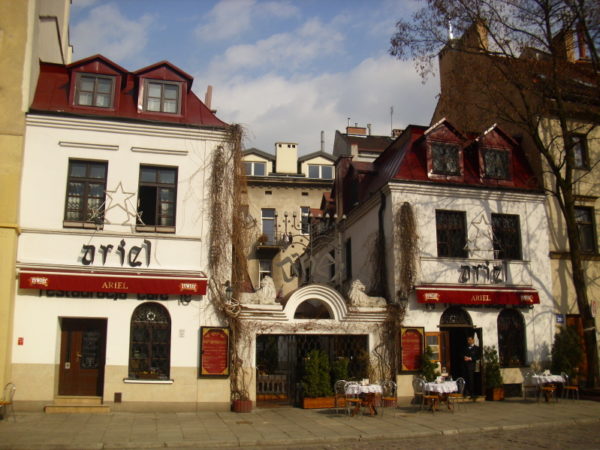 It is a historical district of Kraków and Kraków Old Town. Since its inception in the fourteenth century to the early nineteenth century, Kazimierz has been an independent city, a royal city of the Crown of the Polish Kingdom, a location south of the Old Town of Kraków Old Town, separated from it by a branch of the Vistula river. For many centuries, Kazimierz was a place of coexistence and interpenetration of ethnic Polish and Jewish cultures. Its northeastern part of the district was historic Jewish, whose Jewish inhabitants were forcibly relocated in 1941 by the German occupying forces into the Krakow ghetto just across the river in Podgórze. Today Kazimierz is one of the major tourist attractions of Krakow and an important center of cultural life of the city.
It is a historical district of Kraków and Kraków Old Town. Since its inception in the fourteenth century to the early nineteenth century, Kazimierz has been an independent city, a royal city of the Crown of the Polish Kingdom, a location south of the Old Town of Kraków Old Town, separated from it by a branch of the Vistula river. For many centuries, Kazimierz was a place of coexistence and interpenetration of ethnic Polish and Jewish cultures. Its northeastern part of the district was historic Jewish, whose Jewish inhabitants were forcibly relocated in 1941 by the German occupying forces into the Krakow ghetto just across the river in Podgórze. Today Kazimierz is one of the major tourist attractions of Krakow and an important center of cultural life of the city.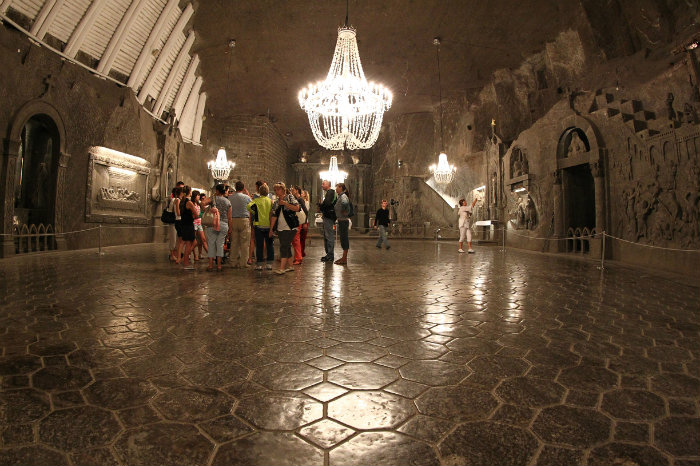 Located 20 km from Cracow city center, the “Wieliczka” Salt Mine is one of the most valuable monuments of material and spiritual culture in Poland. It reaches a depth of 327 meters, and extends via horizontal passages and chambers for over 287 kilometers (178 miles). The rock salt is naturally of varying shades of grey, resembling unpolished granite rather than the white crystalline substance that might be expected. It is a world class monument, featuring among twelve objects on the UNESCO’s World Cultural and Natural Heritage List. Today, the “Wieliczka” Salt Mine combines many centuries of tradition and modernity, the history of several hundred years and an underground metropolis with extensive infrastructure.
Located 20 km from Cracow city center, the “Wieliczka” Salt Mine is one of the most valuable monuments of material and spiritual culture in Poland. It reaches a depth of 327 meters, and extends via horizontal passages and chambers for over 287 kilometers (178 miles). The rock salt is naturally of varying shades of grey, resembling unpolished granite rather than the white crystalline substance that might be expected. It is a world class monument, featuring among twelve objects on the UNESCO’s World Cultural and Natural Heritage List. Today, the “Wieliczka” Salt Mine combines many centuries of tradition and modernity, the history of several hundred years and an underground metropolis with extensive infrastructure.The most useful links:
http://www.krakow.pl/english/visit_krakow
https://wawel.krakow.pl/en
https://www.wieliczka-saltmine.com
Auschwitz-Birkenau Memorial and Museum
Auschwitz-Birkenau. Former German Nazi Concentration and Extermination Camp. 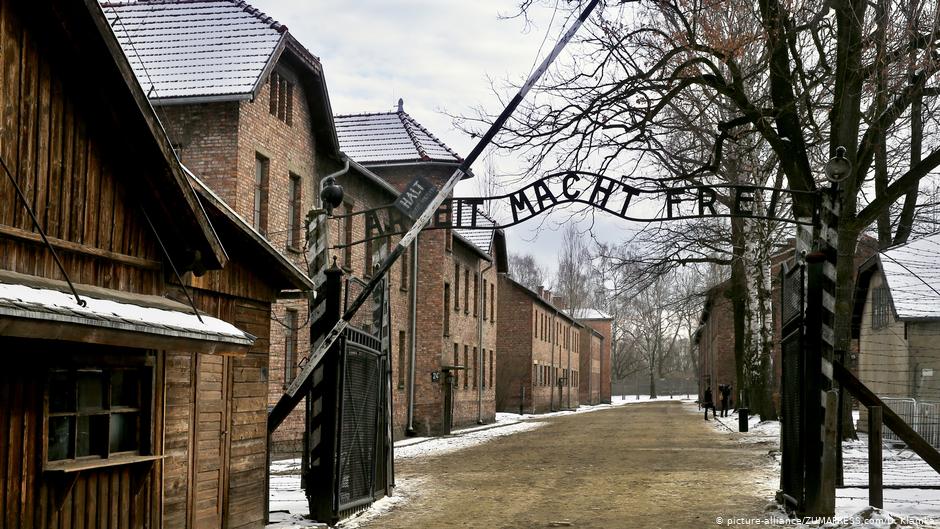 The largest of the German Nazi concentration camps and extermination centers is located 60 km from Gliwice. Over 1 million people lost their lives here. All over the world, Auschwitz has become a symbol of terror, genocide, and the Holocaust. It was established by Germans in 1940, in the suburbs of Oświęcim, a Polish city that was annexed to the Third Reich by the Nazis.
The largest of the German Nazi concentration camps and extermination centers is located 60 km from Gliwice. Over 1 million people lost their lives here. All over the world, Auschwitz has become a symbol of terror, genocide, and the Holocaust. It was established by Germans in 1940, in the suburbs of Oświęcim, a Polish city that was annexed to the Third Reich by the Nazis.
Museum of Auschwitz-Birkenau contains two parts: Camp I Auschwitz and Camp II Auschwitz Birkenau. The area covers 191 hectares (470 acres), twenty of them in camp Auschwitz I and 171 hectares in camp Auschwitz II. Since 1979, the former concentration camp has belonged to the World Cultural Heritage and more than 25 million people have visited the museum.
The larger part of the exhibitions are in the area of the former Camp I "Auschwitz". Guided tours take around three hours, but access is possible without guides from 16-18:00 (as of 2019). This part is situated short of 2 km south of the current train station Oświęcim. From there, shuttle buses go to Camp II, originally called KZ Auschwitz-Birkenau (the combined names was adopted for the whole museum and the UNESCO world heritage site, which however encompass both main camps and some further sites) situated around 2 km to the north-west of Camp I. In case of a longer waiting time for a tour of the exhibitions in Camp I, that can thus be utilized for a visit to Camp II. Please note, that entrance to both Camps is free, but entrance to Camp I requires in advance online tickets booking.
Auschwitz-Birkenau. Former German Nazi Concentration and Extermination Camp.  The largest of the German Nazi concentration camps and extermination centers is located 60 km from Gliwice. Over 1 million people lost their lives here. All over the world, Auschwitz has become a symbol of terror, genocide, and the Holocaust. It was established by Germans in 1940, in the suburbs of Oświęcim, a Polish city that was annexed to the Third Reich by the Nazis.
The largest of the German Nazi concentration camps and extermination centers is located 60 km from Gliwice. Over 1 million people lost their lives here. All over the world, Auschwitz has become a symbol of terror, genocide, and the Holocaust. It was established by Germans in 1940, in the suburbs of Oświęcim, a Polish city that was annexed to the Third Reich by the Nazis.
Museum of Auschwitz-Birkenau contains two parts: Camp I Auschwitz and Camp II Auschwitz Birkenau. The area covers 191 hectares (470 acres), twenty of them in camp Auschwitz I and 171 hectares in camp Auschwitz II. Since 1979, the former concentration camp has belonged to the World Cultural Heritage and more than 25 million people have visited the museum.
The larger part of the exhibitions are in the area of the former Camp I "Auschwitz". Guided tours take around three hours, but access is possible without guides from 16-18:00 (as of 2019). This part is situated short of 2 km south of the current train station Oświęcim. From there, shuttle buses go to Camp II, originally called KZ Auschwitz-Birkenau (the combined names was adopted for the whole museum and the UNESCO world heritage site, which however encompass both main camps and some further sites) situated around 2 km to the north-west of Camp I. In case of a longer waiting time for a tour of the exhibitions in Camp I, that can thus be utilized for a visit to Camp II. Please note, that entrance to both Camps is free, but entrance to Camp I requires in advance online tickets booking.
For more details and reservation please visit http://auschwitz.org/en/
Local attractions
Gliwice
Gliwice is one of the oldest and most beautiful cities in the Upper Silesia. Rich history of the city, interesting architecture and differentiated cultural, sports and recreational life make the city not only a perfect place for living, but also a popular tourist destination. The city was founded before 1276 on Magdeburg Law. At the twilight of the Middle Ages the town occupied the territory of a few hectares and it was inhabited by ca. 900 people. The majority of them were newcomers from Western Europe and Lower Silesia. Over the centuries the city belonged to various countries and it was ruled by the Poles, the Czechs and the Germans. Gliwice offers variety of torist attractions, places to visit and cultural events. The most important are listed below:
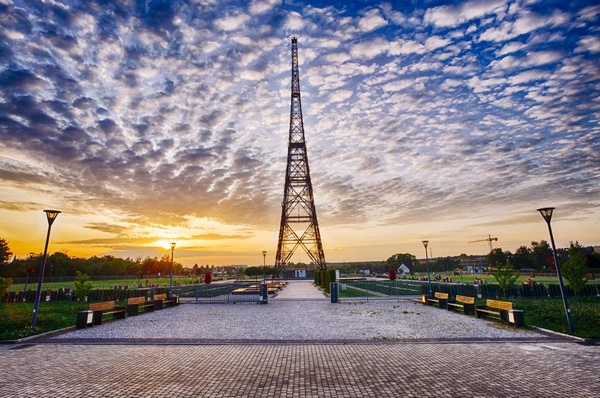 is a symbol of Gliwice. Wooden, larch, 111 m high Radio Station mast from 1935 is the highest wood structure in the world. The Gleiwitz Provocation incident took place here in 1939. It was a covert Nazi German attack on the German radio station Sender Gleiwitz on the night of 31 August 1939. The attack was a false flag operation on the eve of the invasion of Poland leading up to World War II.
is a symbol of Gliwice. Wooden, larch, 111 m high Radio Station mast from 1935 is the highest wood structure in the world. The Gleiwitz Provocation incident took place here in 1939. It was a covert Nazi German attack on the German radio station Sender Gleiwitz on the night of 31 August 1939. The attack was a false flag operation on the eve of the invasion of Poland leading up to World War II. central point of Gliwice includes a 73 × 74 m, outlined in the latter half of 13th century, with two streets leading from each of its corners. The Main Square was the centre of local political, economic and social life of the city ever since its creation. It was here that city patricians dabbling in trade and entrepreneurship lived, it also hosted various events. The medieval buildings of the Main Square no longer exist. Most of the current tenement houses were built during later centuries – mainly during 19th and 20th centuries – loosely resembling Renaissance or classic styles. It is an effect of the post-war restoration of some tenement houses of the Gliwice Old Town under the supervision of architect Franciszek Maurer.
central point of Gliwice includes a 73 × 74 m, outlined in the latter half of 13th century, with two streets leading from each of its corners. The Main Square was the centre of local political, economic and social life of the city ever since its creation. It was here that city patricians dabbling in trade and entrepreneurship lived, it also hosted various events. The medieval buildings of the Main Square no longer exist. Most of the current tenement houses were built during later centuries – mainly during 19th and 20th centuries – loosely resembling Renaissance or classic styles. It is an effect of the post-war restoration of some tenement houses of the Gliwice Old Town under the supervision of architect Franciszek Maurer.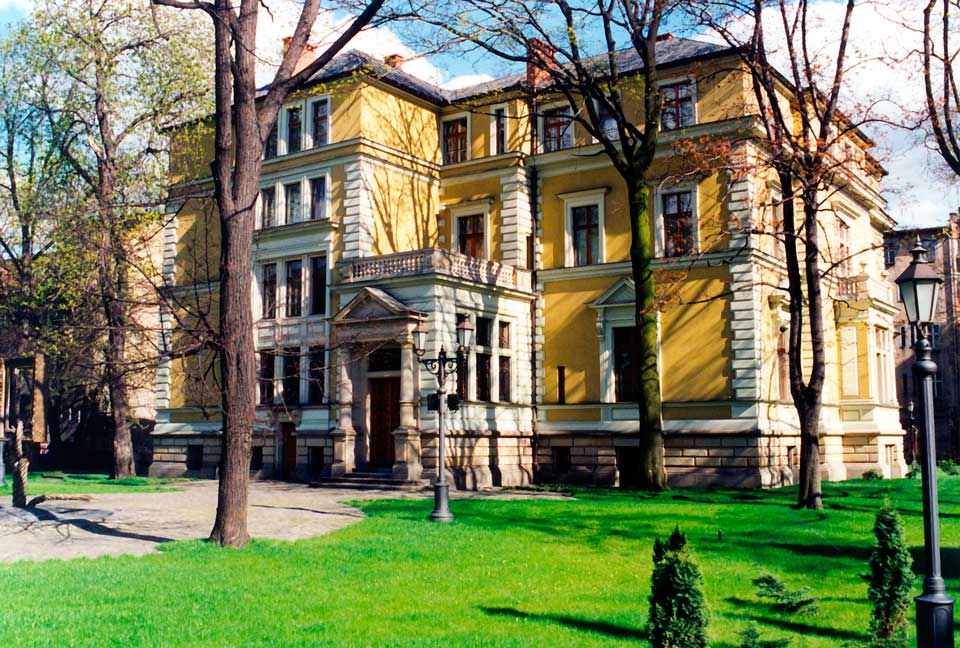 is an example of perfectly preserved 19th century residential property styled as a Renaissance villa. It was once owned by a German industrial tycoon Oscar Caro and in 1934 it was offered by the city as the permanent site of the local museum. The two-level property built during the 1882–1885 period (the second floor was added in 1920s), has a spacious, eclectic garden. Currently, the villa and the garden are surrounded with a faithfully reconstructed fence made of metal and stone. The interior retained well preserved decorations and elements: well-decorated ceilings, wooden wall panels, floor panels, door and window joinery. The building is used as the main office of Museum in Gliwice.
is an example of perfectly preserved 19th century residential property styled as a Renaissance villa. It was once owned by a German industrial tycoon Oscar Caro and in 1934 it was offered by the city as the permanent site of the local museum. The two-level property built during the 1882–1885 period (the second floor was added in 1920s), has a spacious, eclectic garden. Currently, the villa and the garden are surrounded with a faithfully reconstructed fence made of metal and stone. The interior retained well preserved decorations and elements: well-decorated ceilings, wooden wall panels, floor panels, door and window joinery. The building is used as the main office of Museum in Gliwice.Please visit: https://gliwice.eu/en/
Katowice
Katowice is the capital city of the Silesian Voivodeship (or province), and a member town of the Upper Silesia and Dąbrowa Basin Metropolis. The population of the city is about 300 000 and the wider Katowice urban area has the population of approximately 2 million people. Throughout the mid-18th century, Katowice had developed into a village upon the discovery of rich coal reserves in the area. The outbreak of World War I was favourable for Katowice due to the prospering steel industry. In 1939, after the Wehrmacht seized the town, Katowice and the provinces were incorporated into the Third Reich. Returned to Poland in 1945. Katowice is a center of science, culture, industry, business, trade, and transportation in Upper Silesia and southern Poland.
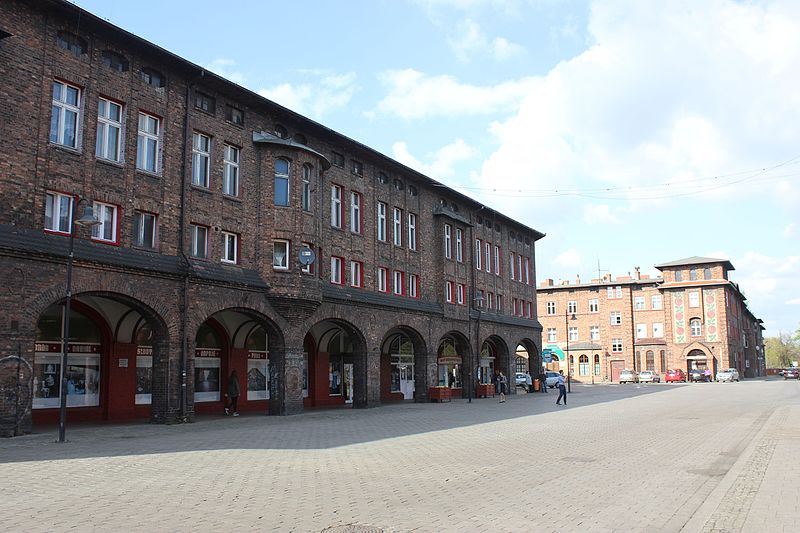 It is a historic district of Katowice city. Interesting architecture and town planning and its industrial heritage make the district worth to visit. The remnants of the original workers' housing estate familoks (specialized multi-family residences) comprise one of Poland's official national Historic Monuments.
It is a historic district of Katowice city. Interesting architecture and town planning and its industrial heritage make the district worth to visit. The remnants of the original workers' housing estate familoks (specialized multi-family residences) comprise one of Poland's official national Historic Monuments.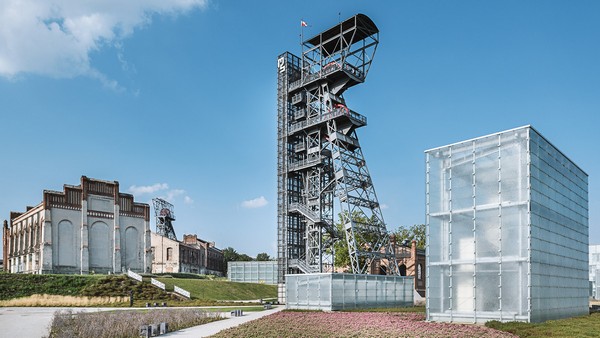 In the heart of the city, next to the Spodek Sport and Show Arena, is a new and unique area called the Culture Zone. Along with Spodek, it consists of the International Congress Centre, the seat of the new Polish National Radio Symphony Orchestra, and the Silesian Museum. All are architectural gems that have received multiple awards for their unique design. These new buildings, constructed in place of the former Katowice coal mine, have brought a new standard of quality to a revitalized part of the city.
In the heart of the city, next to the Spodek Sport and Show Arena, is a new and unique area called the Culture Zone. Along with Spodek, it consists of the International Congress Centre, the seat of the new Polish National Radio Symphony Orchestra, and the Silesian Museum. All are architectural gems that have received multiple awards for their unique design. These new buildings, constructed in place of the former Katowice coal mine, have brought a new standard of quality to a revitalized part of the city.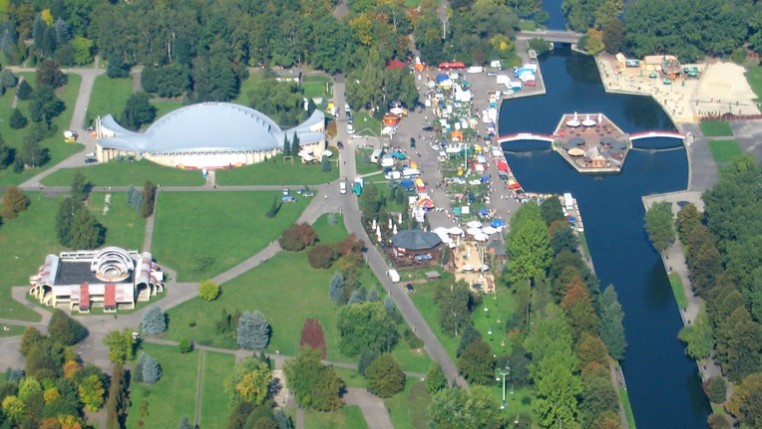 It is a recreation complex in the center of the Upper-Silesian Metropolis at a border of Chorzów and Katowice cities. The area of the park is 620 hectares. By comparison, it's almost twice as big as Central Park in New York. In the park are located i) Silesian Zoological Garden, ii) Legendia Silesian Amusement Park, iii) Silesian Planetarium, iv) Silesian Stadium, v) Upper Silesian Ethnographic Park, vi) Rose garden and many, many other.
It is a recreation complex in the center of the Upper-Silesian Metropolis at a border of Chorzów and Katowice cities. The area of the park is 620 hectares. By comparison, it's almost twice as big as Central Park in New York. In the park are located i) Silesian Zoological Garden, ii) Legendia Silesian Amusement Park, iii) Silesian Planetarium, iv) Silesian Stadium, v) Upper Silesian Ethnographic Park, vi) Rose garden and many, many other.The most useful links:
https://www.katowice.eu/en/en
http://www.mckkatowice.pl/pl/culture-zone/94/
http://www.en.parkslaski.pl/
Tarnowskie Góry
Tarnowskie Góry it is a town in Silesia region, 20 km north from Gliwice, located in the Silesian Highlands. The population of the city is about 60 000. The most famous places in the town are the Historic Silver Mine of Tarnowskie Góry, a UNESCO World Heritage Site and Black Trout Adit. They are remnants of a silver mining industry.
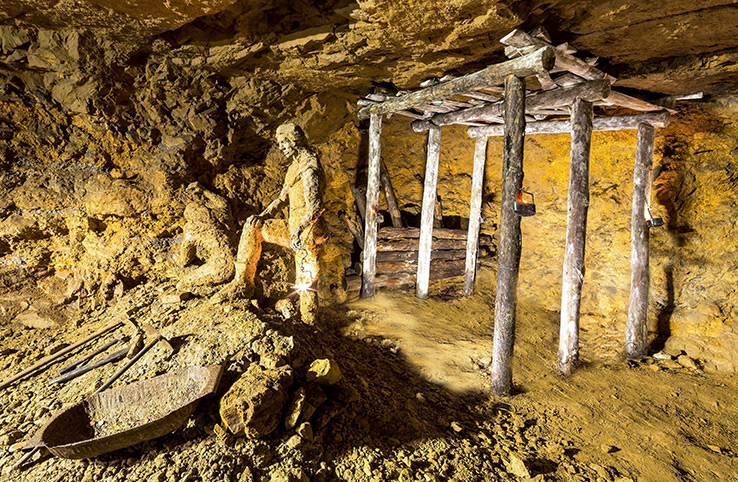 is a mining museum as an Anchor point on the European Route of Industrial Heritage. The region of Tarnowskie Góry is known for historic lead-ore mining. The lead-ores contain quite a big admixture of silver. That's why beginning from 1526 when the new deposits of lead (mostly galena) were found, the settle started to grow quickly. The lead-ore mining in Tarnowskie Góry stopped in 1912 because of resource shortage. However, a huge amount of past mining traces is left, both underground and overground. The Historic silver mine opened in 1976. The visit in Historic Silver Mines starts in an interactive museum where tourists get the knowledge of methods of silver, lead and zinc ore extraction as well as underground mine drainage. Then tourists go underground. The trail is 1,749 meters long; 270 meters are travelled by boats.
is a mining museum as an Anchor point on the European Route of Industrial Heritage. The region of Tarnowskie Góry is known for historic lead-ore mining. The lead-ores contain quite a big admixture of silver. That's why beginning from 1526 when the new deposits of lead (mostly galena) were found, the settle started to grow quickly. The lead-ore mining in Tarnowskie Góry stopped in 1912 because of resource shortage. However, a huge amount of past mining traces is left, both underground and overground. The Historic silver mine opened in 1976. The visit in Historic Silver Mines starts in an interactive museum where tourists get the knowledge of methods of silver, lead and zinc ore extraction as well as underground mine drainage. Then tourists go underground. The trail is 1,749 meters long; 270 meters are travelled by boats.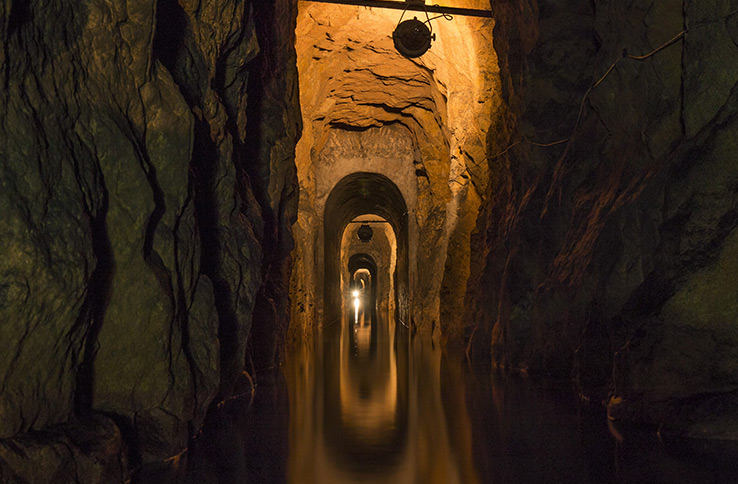 is the longest underground tourist route in Poland travelled by boats. It's a part of one of 8 adits dug in the area to drain the workings. The Black Trout Adit is located in a park in the west of the town Tarnowskie Góry. Access is by two shafts Ewa and Sylwester (the traffic is alternating). The guide puts the boats in motion and tells the stories connected with the place. The tourist route was opened in 1957. Due to terrain profile, the route is located 20 to 30 m underground, and is 600 m long. Its current name Black Trout Adit came from trouts, that used to penetrate the adit from a river, seeming black in dim lights. Width of the adit varies from 1.2 m to 2.5 m, height to 4 m, water depth from 0.7 m to 1 m. The tourists travel in boat trains, pushed forward by guides.
is the longest underground tourist route in Poland travelled by boats. It's a part of one of 8 adits dug in the area to drain the workings. The Black Trout Adit is located in a park in the west of the town Tarnowskie Góry. Access is by two shafts Ewa and Sylwester (the traffic is alternating). The guide puts the boats in motion and tells the stories connected with the place. The tourist route was opened in 1957. Due to terrain profile, the route is located 20 to 30 m underground, and is 600 m long. Its current name Black Trout Adit came from trouts, that used to penetrate the adit from a river, seeming black in dim lights. Width of the adit varies from 1.2 m to 2.5 m, height to 4 m, water depth from 0.7 m to 1 m. The tourists travel in boat trains, pushed forward by guides.Please visit: https://kopalniasrebra.pl/en/homepage/
Zabrze
Zabrze is a neighbour city to Gliwice in Silesia region. It is in the Silesian Highlands, on the Bytomka River, a tributary of the Oder. In 1905, the Zabrze commune was formed and in 1915 renamed to Hindenburg in honour of Generalfeldmarschall Paul von Hindenburg. Zabrze received its city charter in 1922. Just five years after founding Hindenburg became the biggest city in German Upper Silesia and the second biggest City in German Silesia after Breslau. In 1945 and the town's name was changed to the historic Zabrze. The most interesting places to visit are Guido Coal Mine museum and Queen Luisa Adit.
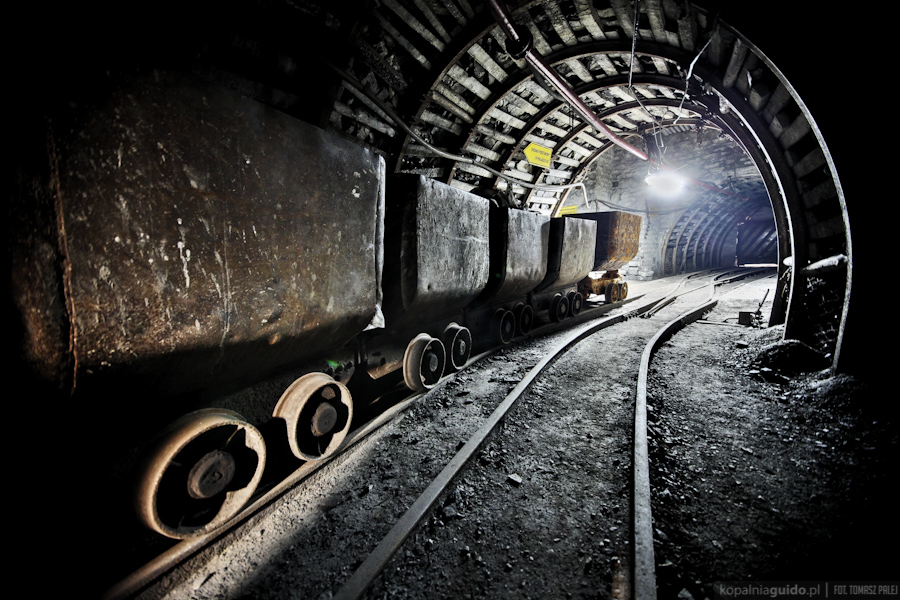 Two excellently preserved mining levels are waiting for you 170 and 320 metres below the surface in the Guido Coal Mine. You will go there with the authentic elevator (in Silesia called “shola”), the same that is used in active coal mines. The express ride in darkness takes just several dozen of seconds! During the tour of the 170 level you will look into originally preserved horse stables and you will learn about the role that these animals played in the history of mining. You will also see what type of dangers wait for the miners working underground and thanks to the multimedia effects almost “feel” the first-hand experience on yourself. The experience at 320 level is mostly connected with exploring the development of mining technology from the end of the 19th century up to modern times.
Two excellently preserved mining levels are waiting for you 170 and 320 metres below the surface in the Guido Coal Mine. You will go there with the authentic elevator (in Silesia called “shola”), the same that is used in active coal mines. The express ride in darkness takes just several dozen of seconds! During the tour of the 170 level you will look into originally preserved horse stables and you will learn about the role that these animals played in the history of mining. You will also see what type of dangers wait for the miners working underground and thanks to the multimedia effects almost “feel” the first-hand experience on yourself. The experience at 320 level is mostly connected with exploring the development of mining technology from the end of the 19th century up to modern times.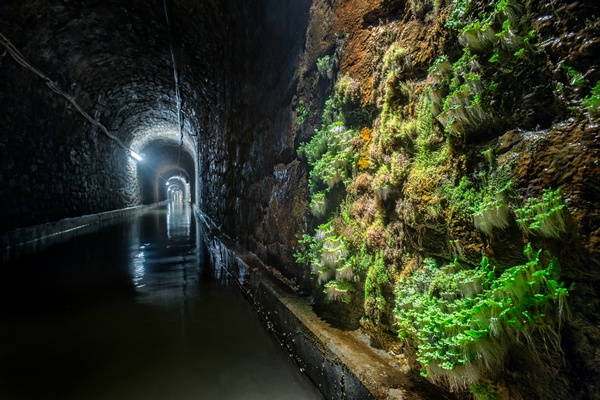 The Queen Louise (Królowa Luiza) Mine opened for business in 1791, one year after Salomon Izaak first discovered coal below the ground. One of the oldest mines in the region, your visit starts off at ground level where you’ll find chunky pieces of machinery, pistons, dials, pipes, photo displays and other industrial detritus clustered around the old ‘Karnell’ shaft. Pride of place goes to a steam-powered hoist that made its debut in 1915 to a design born in Duelmen, Germany; such was the quality of the workmanship that it continued to be used until 1990. The underground sections are split into two levels for visitors, the first of which is a boat trip along an underground river spanning 1130m, while a guide explains the history and culture of the mine. At the 2nd level, 40m below ground, you are shown the technologies used for mining over the last 200 years, right up to the huge machinery of the 21st century.
The Queen Louise (Królowa Luiza) Mine opened for business in 1791, one year after Salomon Izaak first discovered coal below the ground. One of the oldest mines in the region, your visit starts off at ground level where you’ll find chunky pieces of machinery, pistons, dials, pipes, photo displays and other industrial detritus clustered around the old ‘Karnell’ shaft. Pride of place goes to a steam-powered hoist that made its debut in 1915 to a design born in Duelmen, Germany; such was the quality of the workmanship that it continued to be used until 1990. The underground sections are split into two levels for visitors, the first of which is a boat trip along an underground river spanning 1130m, while a guide explains the history and culture of the mine. At the 2nd level, 40m below ground, you are shown the technologies used for mining over the last 200 years, right up to the huge machinery of the 21st century.Please visit: https://kopalniaguido.pl/index.php/en/
Other nearby attractions
Częstochowa
Częstochowa is a city in southern Poland on the Warta River. It is situated in the Silesian Voivodeship (administrative division) Częstochowa is historically part of Lesser Poland, not of Silesia. before 1795 it belonged to the Kraków Voivodeship. Częstochowa is located in the Kraków-Częstochowa Upland. The city is known for the famous Pauline monastery of Jasna Góra, which is the home of the Black Madonna painting, a shrine to the Virgin Mary.
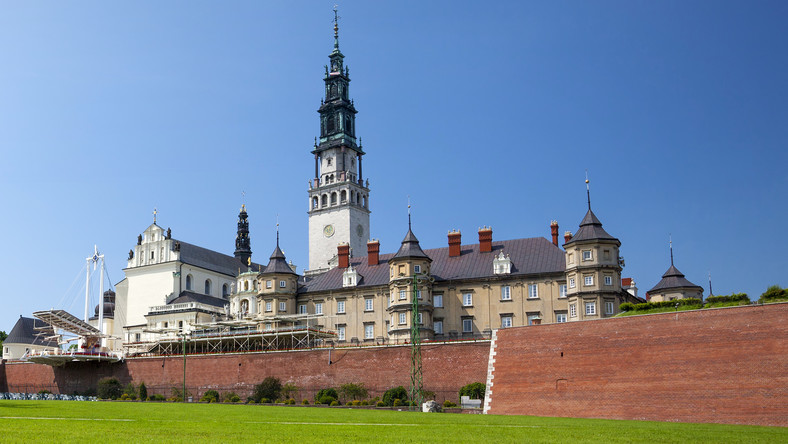 was founded in 1382 by Pauline monks who came from Hungary at the invitation of Władysław, Duke of Opole. The monastery has been a pilgrimage destination for hundreds of years, and it contains an important icon of the Virgin Mary. The icon, depicting the Mother of God with the Christ Child, is known as the Black Madonna of Częstochowa or Our Lady of Częstochowa, which is widely venerated and credited with many miracles. Every year since the Middle Ages, thousands of Poles go in pilgrim groups to visit Jasna Góra. In 2011, it was estimated that 3.2 million pilgrims from 80 countries around the world went to the shrine.
was founded in 1382 by Pauline monks who came from Hungary at the invitation of Władysław, Duke of Opole. The monastery has been a pilgrimage destination for hundreds of years, and it contains an important icon of the Virgin Mary. The icon, depicting the Mother of God with the Christ Child, is known as the Black Madonna of Częstochowa or Our Lady of Częstochowa, which is widely venerated and credited with many miracles. Every year since the Middle Ages, thousands of Poles go in pilgrim groups to visit Jasna Góra. In 2011, it was estimated that 3.2 million pilgrims from 80 countries around the world went to the shrine.Please visit: https://jasnagora.pl/en/
Będzin
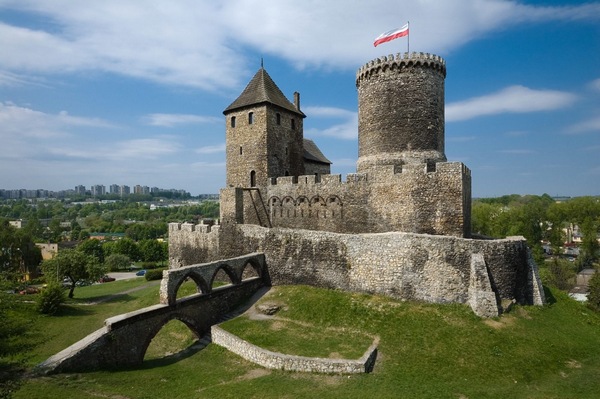 The castle is dated to the 14th century. It was an important fortification in the Kingdom of Poland and later, the Polish-Lithuanian Commonwealth. Today a museum is located in the castle.
The castle is dated to the 14th century. It was an important fortification in the Kingdom of Poland and later, the Polish-Lithuanian Commonwealth. Today a museum is located in the castle.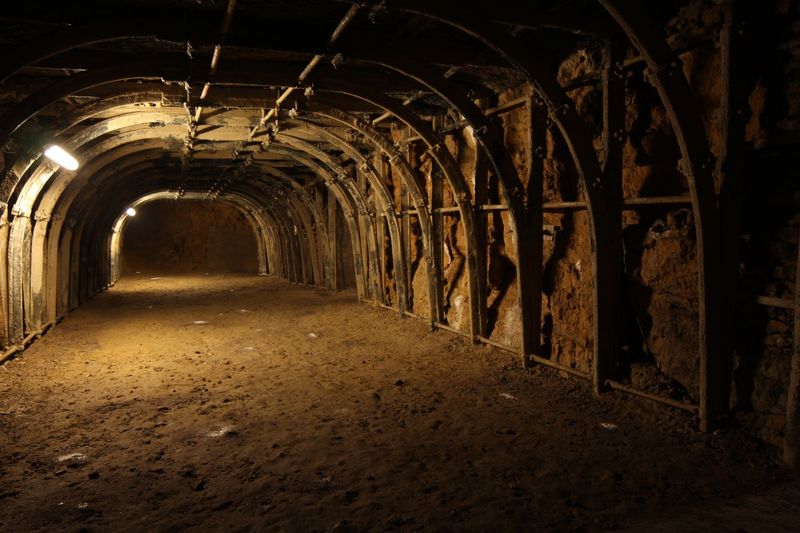 The Będzin Underground is located near the Będzin Castle. It is underground tourist route, arranged in a former German anti-aircraft shelter from World War II. Sightseeing is possible seven days a week - by appointment by phone.
The Będzin Underground is located near the Będzin Castle. It is underground tourist route, arranged in a former German anti-aircraft shelter from World War II. Sightseeing is possible seven days a week - by appointment by phone.Please visit (in polish): https://muzeumzaglebia.pl/
Ojców and Pieskowa Skała
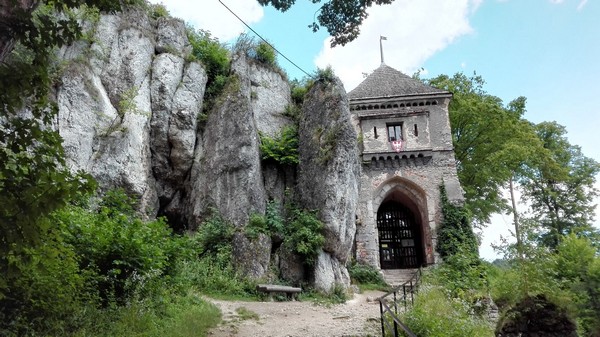 are villages that are placed in Ojców National Park. The park contains numerous of attractions like castles, including a ruined Gothic castle at Ojców and a better-preserved Renaissance castle at Pieskowa Skała. There are two museums in the park and two caves that are opened for visitors: Łokietek Cave and Dark Cave. In addition, it is also worth seeing: Chapel on the water, mill, The hermitage of Salomea and The Hercules’ mace.
are villages that are placed in Ojców National Park. The park contains numerous of attractions like castles, including a ruined Gothic castle at Ojców and a better-preserved Renaissance castle at Pieskowa Skała. There are two museums in the park and two caves that are opened for visitors: Łokietek Cave and Dark Cave. In addition, it is also worth seeing: Chapel on the water, mill, The hermitage of Salomea and The Hercules’ mace.Ogrodzieniec
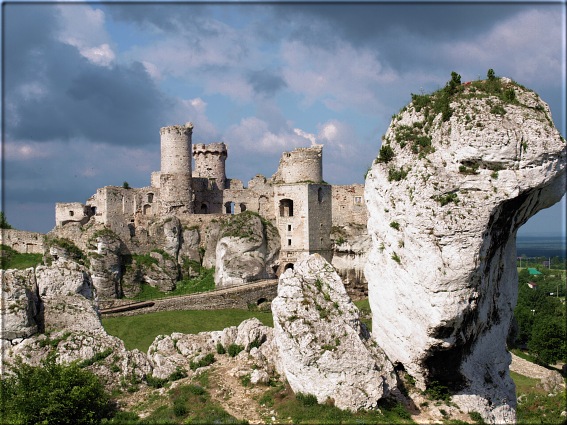 is a ruined medieval castle in the semi-mountainous highland region called the Polish Jura in south-central Poland. The castle was originally built in the 14th–15th century. There is a museum in the castle, that contains a rich collection of information about past and present days.
is a ruined medieval castle in the semi-mountainous highland region called the Polish Jura in south-central Poland. The castle was originally built in the 14th–15th century. There is a museum in the castle, that contains a rich collection of information about past and present days.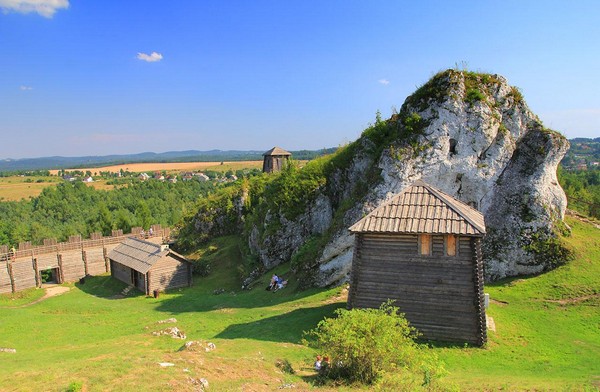 is located close to The Ogrodzieniec Castle. On the mountain is located a reconstructed stronghold.
is located close to The Ogrodzieniec Castle. On the mountain is located a reconstructed stronghold.Please visit: https://www.zamek-ogrodzieniec.pl/?jez=en






